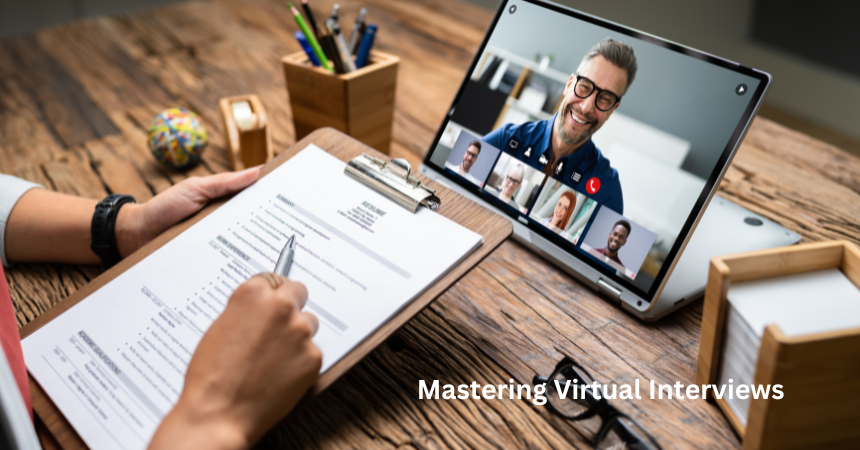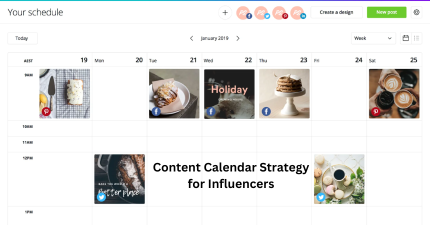
- 29 Oct, 2024
Mastering Virtual Interviews: Essential Strategies to Stand Out
In today’s fast-paced, tech-driven world, the job market is evolving faster than ever, and virtual interviews have become the new norm. Gone are the days of dressing up and commuting to a conference room; now, your living room or home office can double as your stage for landing that dream job! But how do you truly stand out in this digital landscape where first impressions are made through screens? Fear not! In “Mastering Virtual Interviews: Essential Strategies to Stand Out,” we’ll unlock the secrets to captivating your interviewer from behind a webcam. Whether you're a seasoned professional or stepping into the workforce for the first time, these essential strategies will equip you with everything you need to shine in your next virtual interview. Get ready to boost your confidence and showcase your unique talents like never before—your future career awaits!
Introduction: The Rise of Virtual Interviews
The world of job interviews has dramatically transformed in recent years. With the rise of technology, virtual interviews have become a standard practice for employers and candidates alike. No longer confined to traditional settings, this format offers a unique opportunity to showcase your skills from the comfort of your home. But with this shift comes new challenges that require fresh strategies.
Whether you're applying for a remote position or navigating the future landscape of hybrid workplaces, mastering virtual interviews is essential. Standing out among countless applicants necessitates not just preparation but effective techniques tailored to this digital environment. Are you ready to elevate your interview game? Let’s dive into what it takes to shine in front of that webcam and land your dream job!
Understanding the Different Types of Virtual Interviews
Virtual interviews have transformed how candidates connect with employers. Each type serves a unique purpose and requires different preparation.
Live video interviews are the most common format. They mimic traditional face-to-face meetings, allowing for real-time interaction. You can gauge reactions and adapt your responses on the fly.
Pre-recorded video interviews take a different approach. Candidates answer set questions within a specific timeframe, often without an interviewer present. This format allows you to showcase your personality but may feel more scripted.
Phone and audio interviews offer simplicity and convenience. While lacking visual elements, they still demand strong communication skills. Preparing for this means honing your verbal delivery since first impressions rely solely on your voice.
Understanding these formats is crucial in tailoring your strategy for each scenario, maximizing your chances of making a lasting impression.
Live Video Interviews
Live video interviews have become a staple in the hiring process. Candidates connect with employers through platforms like Zoom or Microsoft Teams, bringing a personal touch to remote interactions.
These real-time sessions allow for immediate feedback and genuine conversation. Interviewers can gauge enthusiasm and personality more effectively than through emails alone.
Preparation is key here. Familiarize yourself with the software before the interview day to avoid technical glitches that could distract from your performance.
A quiet environment is crucial. Ensure your background is tidy and free of distractions, providing a professional atmosphere that speaks volumes about your readiness.
Remember, it's not just about what you say but how you say it. Your body language should be engaging; sit up straight and nod occasionally to show you're actively listening.
Pre-recorded Video Interviews
Pre-recorded video interviews have become a popular choice for employers. They allow candidates to record their responses at their convenience. This format eliminates the pressure of real-time interactions.
Candidates often receive a set of questions beforehand. They can take time to craft thoughtful responses without the stress of an audience. However, it's essential to simulate the interview setting as closely as possible. Treat it like a live session.
One advantage is flexibility; you can choose when and where to conduct your recording. Still, be mindful of lighting and background noise—these factors greatly affect how you come across on camera.
Feedback might not be immediate, but pre-recorded interviews allow companies to review multiple candidates more efficiently. It's crucial to stay focused and articulate clearly throughout your delivery, even if you're recording alone in your living room.
Phone and Audio Interviews
Phone and audio interviews are often overlooked but play a crucial role in the hiring process. They serve as an efficient way to screen candidates quickly before inviting them for more formal conversations.
Without visual cues, these interviews rely heavily on verbal communication. It’s essential to articulate your thoughts clearly and confidently. Your tone can convey enthusiasm or hesitation, so keep it positive.
One advantage of phone interviews is their flexibility. You can take the call from a comfortable location, but be cautious about background noise that could distract you or the interviewer.
Prepare by having key points handy—your resume, notes on skills, or questions for the interviewer. This not only keeps you organized but also allows for smoother responses.
Lastly, remember to listen actively. Engaging with what the interviewer says will demonstrate your interest and help build rapport even without face-to-face interaction.
Benefits and Challenges of Virtual Interviews
Virtual interviews have transformed the hiring landscape, offering benefits that both job seekers and employers appreciate. One significant advantage is convenience. Candidates can interview from anywhere, eliminating travel time and costs. This flexibility often leads to a more relaxed atmosphere.
However, virtual formats also present challenges. Technical issues like poor internet connection or malfunctioning equipment can derail an otherwise promising interview. The lack of in-person interaction may hinder relationship-building between candidates and interviewers.
Moreover, distractions at home can disrupt focus and professionalism during the meeting. It requires strong self-discipline to create a suitable environment for serious discussions.
While virtual interviews expand accessibility for many candidates, they also demand adaptability to navigate their unique hurdles effectively. Balancing these pros and cons becomes crucial for achieving success in this evolving interviewing format.
Preparing for a Successful Virtual Interview
Preparing for a virtual interview is crucial. Start by choosing the right space. Find a quiet, well-lit area where you won’t be interrupted. A clean backdrop can make all the difference.
Next, check your equipment. Test your computer, camera, and microphone ahead of time to ensure everything functions smoothly. Consider using headphones to minimize background noise.
Dressing appropriately matters too. Opt for professional attire that mirrors what you would wear in an in-person meeting. This helps set your mindset and boosts confidence.
Finally, practice makes perfect. Conduct mock interviews with friends or family to get comfortable speaking on camera. Familiarize yourself with common questions so you can respond confidently when it counts most.
Setting up Your Space and Equipment
Creating the right environment for your virtual interview is crucial. Start by choosing a quiet space free from distractions. Inform anyone at home about your interview time to minimize interruptions.
Lighting plays a significant role in how you appear on camera. Natural light is best, so position yourself near a window if possible. If not, use soft artificial lighting that illuminates your face without casting harsh shadows.
Next, ensure your technology is reliable. Test your computer and internet connection ahead of time to avoid last-minute glitches. Headphones can help reduce background noise and improve audio clarity during the conversation.
Finally, consider the backdrop behind you. A clean and tidy area conveys professionalism. Add personal touches like shelves or plants but keep it simple to maintain focus on you as the candidate rather than what's around you.
Dressing Appropriately for a Virtual Interview
When preparing for a virtual interview, your outfit matters just as much as it would in person. The goal is to project professionalism and confidence through the screen.
Choose clothing that aligns with the company's culture. If you’re applying to a corporate environment, opt for business attire. For creative industries, smart casual can be appropriate while still showing you care about your presentation.
Colors matter too. Solid colors tend to work best on camera; they help maintain focus on you rather than what you're wearing. Avoid busy patterns that can distract both you and the interviewer.
Don’t forget about grooming! A neat appearance contributes significantly to making a positive impression. Hair should be tidy, and makeup (if worn) should enhance rather than overwhelm.
Finally, remember that comfort is key. You want to feel at ease so that nerves don’t get the best of you during this crucial moment.
Practicing with Mock Interviews
Mock interviews are a vital tool in preparing for virtual interviews. They provide a safe space to practice your responses and refine your delivery without the pressure of real-time stakes.
Find a friend or use online platforms that offer mock interview services. This approach not only simulates the experience but also helps you receive constructive feedback. Focus on both content and presentation during these sessions.
Recording yourself can be enlightening too. Watching your performance reveals aspects you might overlook, like pacing or filler words. It’s an opportunity to adjust before the actual interview day arrives.
Don't forget to simulate technical challenges as well. Practice troubleshooting potential issues with video or audio settings so you're ready if something goes wrong during the real thing. Embracing this preparation will enhance your confidence significantly when it counts most.
Essential Strategies to Stand Out in a Virtual Interview
Making a great first impression is crucial. Start with a warm greeting and a confident smile. This sets the tone and creates an immediate connection.
Eye contact can be tricky on camera, but it’s essential. Look directly at the lens instead of your screen to engage your interviewer effectively.
Your body language also speaks volumes. Sit up straight, use hand gestures naturally, and show enthusiasm through nodding or smiling when appropriate.
When discussing your skills and experience, tailor your responses to align with the job description. Use specific examples that showcase how you've made an impact in previous roles.
Technical difficulties can happen unexpectedly. Prepare for this by testing all equipment beforehand and having backup options ready—like using your phone if needed—so you stay calm during hiccups.
Making a Great First Impression
First impressions matter. In a virtual interview, your initial moments can set the tone for the entire conversation. Make sure to greet your interviewer with enthusiasm and a warm smile.
Your background also speaks volumes. Choose a clean, uncluttered setting that reflects professionalism. A simple wall or bookshelf works wonders. Lighting is crucial; ensure your face is well-lit so you come across as approachable and engaged.
Body language plays an important role too. Sit up straight and show confidence through open gestures. Nod occasionally to convey active listening.
Remember to test your technology beforehand to avoid any hitches that could distract from what you're saying. Being ready shows you respect their time and are serious about the opportunity at hand.
These small details combined will help create an impactful first impression that lingers long after the interview ends.
Maintaining Eye Contact and Body Language on Camera
Maintaining eye contact during a virtual interview is crucial. It creates a connection and shows engagement. Look directly at the camera, not the screen. This simple adjustment can make all the difference.
Your body language is equally important. Sit up straight to convey confidence and professionalism. Lean slightly forward to show interest in the conversation.
Avoid distractions like fidgeting or looking away frequently. These habits can undermine your message and distract from your qualifications.
Use hand gestures naturally as you speak; this adds emphasis without being overbearing. Remember, your facial expressions should reflect enthusiasm for the role you're pursuing.
A warm smile goes a long way too, making you approachable and memorable to interviewers. Practicing these elements will help you present yourself authentically on camera while showcasing your personality effectively.
Highlighting Your Skills and Experience Effectively
When discussing your skills and experience, be specific. Highlight quantifiable achievements. Use numbers to illustrate how you’ve made an impact in previous roles.
Tailor your examples to the job description. Identify keywords from the listing and weave them into your narrative. This helps create a direct connection between what you offer and what employers seek.
Storytelling can be powerful too. Share brief anecdotes that showcase challenges you've overcome or innovative solutions you've implemented. This makes your qualifications more memorable.
Remember to stay confident without sounding arrogant. Express enthusiasm for how your unique background aligns with the company’s goals.
Lastly, engage with questions during this part of the conversation. Invite dialogue about topics related to your expertise, showing you're not just interested in talking but also eager to collaborate and learn more about their needs.
Navigating Technical Difficulties
Technical difficulties can strike at the worst moments. A dropped connection or blurry video can disrupt your flow and impact your confidence.
Preparation is key. Test your equipment beforehand to ensure everything works smoothly. Familiarize yourself with the platform being used for the interview, whether it’s Zoom, Skype, or another service.
If issues do arise during the conversation, stay calm. Politely inform the interviewer of the problem and take a moment to troubleshoot if necessary. This shows adaptability and professionalism.
Have a backup plan ready as well. An alternative device—like a smartphone—can save you when technology fails.
Remember to maintain composure; how you respond under pressure can leave a lasting impression on potential employers. They’ll appreciate your resilience in navigating unexpected challenges while keeping things focused on what truly matters: showcasing your skills and fit for their team.
Common Mistakes to Avoid in a Virtual Interview
Virtual interviews can be tricky, and certain pitfalls can cost you the opportunity. One major mistake is not testing technology in advance. A last-minute glitch could derail your interview.
Another common error is neglecting the environment around you. Background noise or clutter can distract both you and the interviewer, so make sure your space is clean and quiet.
Additionally, failing to prepare for questions specific to a virtual setting might leave you stumbling over your words. Research typical virtual interview questions ahead of time.
Many candidates underestimate non-verbal communication as well. Looking away from the camera or appearing disengaged can create a negative impression.
Lastly, don’t forget about time zones if you're interviewing with someone far away. Arriving late—whether by minutes or hours—can signal unprofessionalism before you've even started speaking.
Navigating the world of virtual interviews can feel daunting, but with the right strategies, you can shine. Embrace technology and use it to your advantage. Remember that preparation is key; a well-set space and appropriate attire go a long way in making a lasting impression.
Practice makes perfect—spend time honing your skills through mock interviews. This will help you become comfortable on camera and enhance your confidence.
When it's time for the real interview, focus on establishing rapport from the start. Maintain eye contact to convey engagement and enthusiasm. Use positive body language to support what you're saying. Highlighting your unique skills effectively can set you apart from other candidates.
Technical glitches are inevitable at times; being prepared for these challenges will show resilience and adaptability to potential employers.
Avoid common pitfalls such as distractions or overly casual behavior during an interview setting. Keep professionalism at the forefront while showcasing authenticity.
With these essential strategies in hand, you'll be well-equipped to navigate any virtual interview landscape successfully—and stand out against the competition!




